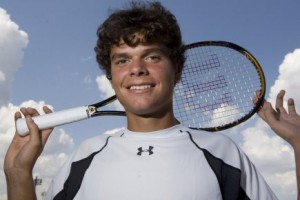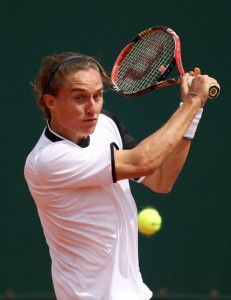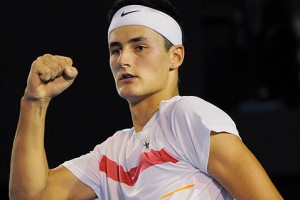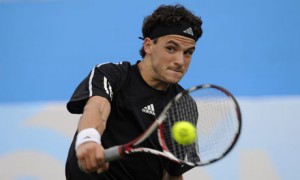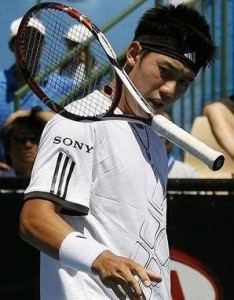Future of Tennis “Dark Horse” Candidates Get Ready for the Upcoming U.S. Open
It stands to reason that the term “dark horse” originates from the world of horse racing.
For those betting on the outcome, it meant that setting odds became difficult when a horse was not known to gamblers.
Today, in the world of sports or politics, it signifies that a person who was not well known emerged as a winner––an unexpected winner.
So while Juan Martin del Potro may not be a “favorite” entering the 2011 U.S. Open, the Argentine cannot be regarded as a “dark horse” because he is well-known in Flushing Meadows.
Del Potro won the US Open title in 2009.
True “dark horses” are not widely known by the general viewing public because they are relatively new on the tennis scene.
These young players have not made much of a name for themselves––yet.
To date, there are six young guns ready to make their way to the top of the men’s game.
They will become the “dark horses” in the upcoming US Open, representing the future of tennis on the men’s side of the draw.
Milos Raonic (Canada): ATP Ranking 28
At age 20, Milos Raonic possesses a big, booming, powerful serve. The Canadian has used it to good advantage so far this year.
Standing 6‘5″, Raonic burst onto the scene at the 2011 Australian Open where he reached the fourth round.
The young Canadian followed his showing in Melbourne by winning the 2011 SAP Open, skyrocketing from being ranked world No. 152 to No. 37 in a month.
Raonic might have continued to fuel much speculation coming into the upcoming US Open after such a good start to his season.
An unfortunate turn of events, however, will more than likely keep his chances of advancing deep into the draw at Flushing Meadows waiting in the wings.
During the second round of Wimbledon in 2011, the Canadian slipped and fell on the wet grass. The subsequent injury required that Raonic undergo hip surgery.
The word is that the Canadian will be unable to play for six weeks, which will eliminate his participation in the upcoming Rogers Cup in Montreal.
It leads some to doubt his ability to bounce back in time to be a factor at this year’s US Open.
The Canadian is currently ranked No. 28, but the continued inactivity will undoubtedly hurt his ranking.
In the meantime, we may have to wait for a month or better until Raonic is completely healed, ready to compete fully fit once again.
But this young gun is touted by many as the future of men’s tennis.
Ryan Harrison (United States): ATP Ranking 94
American Ryan Harrison, 19, holds much promise. U.S. tennis awaits his arrival as an impact player because there will be an inevitable vacuum at the top of the men’s game for the U.S. contingent as Mardy Fish and Andy Roddick reach and surpass age 30.
Harrison has the drive, the skills and the patience to make his way up the rankings. But the young American has a long way to go currently ranked world No. 94.
Harrison has shown moments of tenacity and aggression. For example, in the third round at this year’s Masters at Indian Wells, Harrison defeated Milos Raonic who is another up-and-comer on the tennis scene.
That sent the young American into the fourth round where he confronted World No. 3 Roger Federer. Harrison lost with the final score of 6–7(4), 3–6. But the American played well against the former world No. 1. That added to Harrison’s confidence level.
During the 2011 French Open he gave the No. 5 seed Robin Soderling all he could handle. Harrison was able to take a set off the two-time French Open finalist.
By receiving a spot in the main draw of Wimbledon, Harrison won his first round match and faced the No. 7 seed David Ferrer in the second round. He lost in a five-set match, 7–6(6), 1–6, 6–4, 3–6, 2–6, that extended over two days.
Harrison showed he had the right stuff at times. With experience, the American will begin winning these matches.
After his showing in Atlanta, reaching the semifinals, Harrison shot up 26 points on the rankings ladder from 120 to his current spot of 94.
Expect to see this young man make his mark in men’s tennis in the near future.
Alexandr Dolgopolov (Ukraine): ATP Ranking 27
Sometimes you just have to break free from parental influence and go your own way.
Such was the case with Ukraine-born Alexandr Dolgopolov whose father was a professional tennis player from Russia. The youngster traveled on tour with his parents. From the time he could walk, Dolgopolov played tennis.
His father Oleksandr Dolgopolov coached the famous Russian player Andrei Medvedev.
The Ukraine turned professional in 2006, breaking from his father in 2009 at age 20. Dolgopolov began his tennis career in earnest at that point.
Since 2010, the Ukrainian has made his mark on the men’s tour. It is important to note, however, that Dolgopolov began 2010 still qualifying to get into the main draws of major events.
Earlier this year, Dolgopolov captured everyone’s attention during the 2011 Australian Open. The Ukranian rolled out his best showing at a Grand Slam thus far, reaching the quarterfinals in Melbourne.
He defeated Mikhail Kukushkin in the first round followed by a win over Benjamin Becker in Round 2. Then the young Ukrainian proceeded to overcome Frenchman Jo-Wilfried Tsonga in five sets, 3–6, 6–3, 3–6, 6–1, 6–1.
Finally, Dolgopolov upset World No. 4 Robin Soderling in the fourth round in Melbourne, 1–6, 6–3, 6–1, 4–6, 6–2, reaching his first ever Grand Slam quarterfinal.
In the quarterfinals, Dolgopolov lost to the No. 5 seed, Andy Murray, 5–7, 3–6, 7–6, 3–6.
His run in Melbourne finally ended. But, shortly after the 2011 Australian Open concluded, Dolgopolov broke into the top 30 of the ATP rankings.
Despite some setbacks because of illness, Dolgopolov has managed to hold onto his top 30 ranking, now at No. 27.
With his unorthodox service motion and scintillating all-court game, expect the man from Ukraine to continue to work his way up the rankings ladder.
Bernard Tomic (Australia): ATP Ranking 68
After Bernard Tomic’s run through the draw at last month’s Wimbledon tournament, all eyes will be on the Aussie as he takes the court in New York City.
Remarkably, Tomic had to qualify to get into the main draw at the 2011 All England Club. He had already played three rounds before meeting the No. 28 seed Russian Nikolay Davydenko in the first round.
In the second round, Tomic had to come back from the brink, down two sets to love to defeat another Russian Igor Andreev in five sets.
In the third round, Tomic took out the No. 5 seed, Robin Soderling 6-1, 6-4, 7-5. Soderling had just defeated countryman Lleyton Hewitt in a long five-setter. It was a stunning upset for the teenager.
Finally, in the fourth round, Tomic managed to get by veteran Xavier Malisse in straight sets.
In the quarterfinals, however, Tomic finally met his match in Novak Djokovic. The Aussie lost to the eventual champion but did manage to take a set from the Serb.
It was an inspiring tournament. When the rankings came out on Monday after the tournament concluded, Tomic shot up 87 places in the ATP rankings to No. 71 in the world.
With his serving prowess and his movement on court, Tomic continues to climb up the rankings ladder, resting now at No. 68.
Tomic certainly has all the tools to make it to the top in men’s tennis if he can rein in his temper and cultivate a better relationship with Australian Tennis, not letting distractions take his focus away from the game at hand.
Grigor Dimitrov (Bulgaria): ATP Ranking 57
Another young gun who deserves to be acknowledged as an up-and-comer is Bulgarian Grigor Dimitrov who came out of the juniors with the highest expectations.
Some pundits have compared the young Bulgarian to Roger Federer because of the weight and placement of Dimitrov’s groundstrokes, most especially his backhand.
Dimitrov plays right-handed utilizing a single-handed backhand. According to reports, the Bulgarian considers the backhand down the line as his favorite shot.
To date, his favorite surfaces are hard court and grass.
Regardless of his stated preferences, he has enjoyed some success on the red dirt, reaching the quarterfinals in Munich.
After making the quarterfinals at Eastbourne in preparation for the 2011 Wimbledon tournament, Dimitrov lost to Janko Tipsarevic.
During the second round at Wimbledon the Bulgarian extended Jo-Wilfried Tsonga to four sets, losing 7-6, 4-6, 4-6, 6-7. It was a good effort by Dimitrov.
Obviously as he matures, coaches expect his movement on court to improve as well as his return of serve. The young Bulgarian deserves to be regarded as a rising star in men’s tennis.
Kei Nishikori (Japan): ATP Ranking 49
Kei Nishikori made his initial impression on the tennis public during the US Open of 2008 when as a teenager, he advanced to the fourth round in his debut at the tournament.
He defeated Juan Monaco in the first round and Roko Karanusic of Croatia in the second round.
When he upset the No. 4 seed, David Ferrer in the third round, Nishikori became the first man from Japan to reach the round of 16 at the US Open in the last 71 years.
Of course, in the fourth round he met and was defeated by another teenager, Argentine Juan Martin del Potro 6-3, 6-4, 6-3.
Injury, however, stalled the progress of Nishikori as he sat out most of 2009 dealing with an injured elbow that kept him out of action.
In 2010, the man from Japan finally back in form made it to the third round of the US Open before having to retire in his match with Albert Montanes.
In 2011 Nishikori advanced to the third round of the Australian Open where he lost to Fernando Verdasco of Spain.
He went on to reach the finals of the US Clay Court Championships losing to American Ryan Sweeting.
Nishikori reached the semifinals of Eastbourne prior to Wimbledon where he fell to Serb Janko Tipsarevic. Despite much hope after his showing in Eastbourne, however, Nishikori fell to Lleyton Hewitt in the opening round of Wimbledon.
Nishikori represents a wave of new players from Asia who will undoubtedly impact the men’s game in tennis. He is leading the pack to date and at age 21 has many years to improve his game.
